Enter the dragons
From:China DailyAuthor: 2024-02-04 10:43

Gold dragon and the silver chain with gilded bronze dragon heads, both being among the Tang Dynasty (618-907) collection of the Xi'an Museum. [Photo by Gao Erqiang/China Daily]
The Shanghai Museum is celebrating the upcoming Lunar New Year with new exhibition,Longing for Spring: A Celebration of the Year of the Dragon.
Opened on Jan 26, the exhibition is designed around eight objects, five from the museum's collection and three borrowed from the Liaoning Provincial Institute of Cultural Relics and Archaeology and the Xi'an Museum in Shaanxi province.
The dragon, or long in Chinese, is the only mythical creature among the 12 Chinese zodiac signs. It has been present in legends for thousands of years, and is recognized as a national totem and has a long-held spiritual importance in Chinese culture, according to Chu Xiaobo, director of the Shanghai Museum.
According to the legends, the dragon is capable of changing its size and visibility at will. It can be found flying through the clouds on the spring equinox (chunfen), or hiding in water on the autumn equinox (qiufen). Its potent and mysterious powers — particularly its control over rain — were central to agricultural society. The auspicious creature was historically associated with the East, and used as a symbol to represent imperial power, Chu says, explaining the significance of the dragon in Chinese culture.
Dragons can be found throughout ancient Chinese art and there are many objects bearing the image of the dragon in the Shanghai Museum's collection. So many that Chu Xin, deputy director of the exhibition department of Shanghai Museum, says they picked over 400 artifacts as part of the preliminary selection for the exhibition.
Eventually, the museum chose five objects from its collection and borrowed two Tang Dynasty (618-907) artifacts from the Xi'an Museum and a jade Jue dragon from the Liaoning Provincial Institute of Cultural Relics and Archaeology. The eight artifacts are on display in the museum's ground floor lobby.

Visitors appreciate a coral dragon of the modern period, part of the collection of the Shanghai Museum, atThe Longing for Spring: A Celebration of the Year of the Dragon exhibition.[Photo by Gao Erqiang/China Daily]
The jade Jue dragon dates back around 7,000 years to the Neolithic period between 5,500 BC to 5,000 BC. It is an object from the late Hongshan culture period, and was unearthed at the Niuheliang site in Chaoyang, Liaoning province, in 2003. It has a large head, with pointed ears and protruding jaws. Jue objects are widely believed to be the earliest images of the dragon, and archaeologists have speculated that the image could originally have been based on a pig, bear or even a silkworm.
The most recent piece is a pink coral dragon dating to the late 19th century. Made from a single branch of coral, it depicts a dragon swimming with its head turned back, with a movable ball in its open mouth. The creature's horns point backward, and a little parcel is tied on one of them, as if the dragon is bearing gifts or blessings to the world.
Coral has long been considered precious and auspicious in many parts of the world, and is widely used in jewelry and decorative design. Beautiful as it is, this dragon has never been on public display at the Shanghai Museum. "That's mainly because it is modern, and not as old as most of the artifacts in our collection," Chu Xin explains.
She introduces a flat vase from the reign of Emperor Qianlong (1736-1795). It is a blue-and-white vase with two handles, and depicts a carmine red dragon in clouds. The shape originates in nomadic culture, where water bottles were tied via handles onto horses, she says. Carmine red pigment was introduced to China from Europe in the 1700s, and has been used in ceramics since.
The red dragon on the vase looks especially lively, its four feet spread as if it is dancing.
This is the sixth consecutive year that the museum is presenting a Lunar New Year exhibition, featuring zodiac animals. This year's, despite its modest size, includes dragons from the Neolithic to the modern periods, and from abstract imagery to figurative.
"We hope that visitors will find the versatile representation of the dragon in Chinese culture imperial and solemn, as well as vivid, attractive and lovable," Chu Xin says.
Edit:董麗娜
The copyright of the article and the picture belongs to the original author. If there is any infringement, please contact to delete it